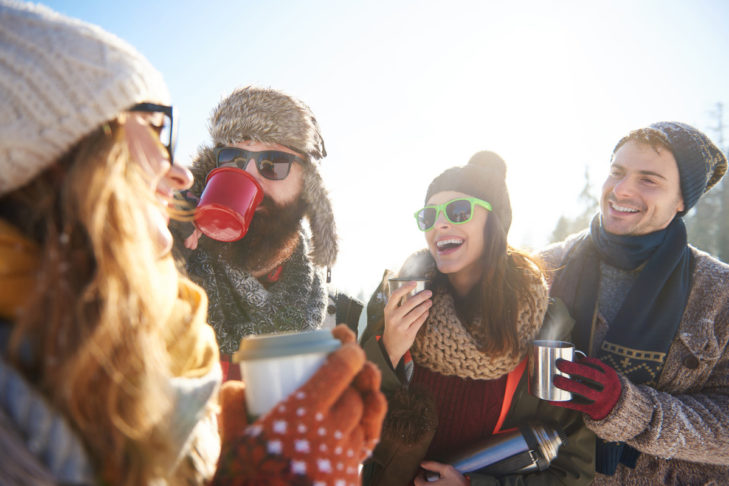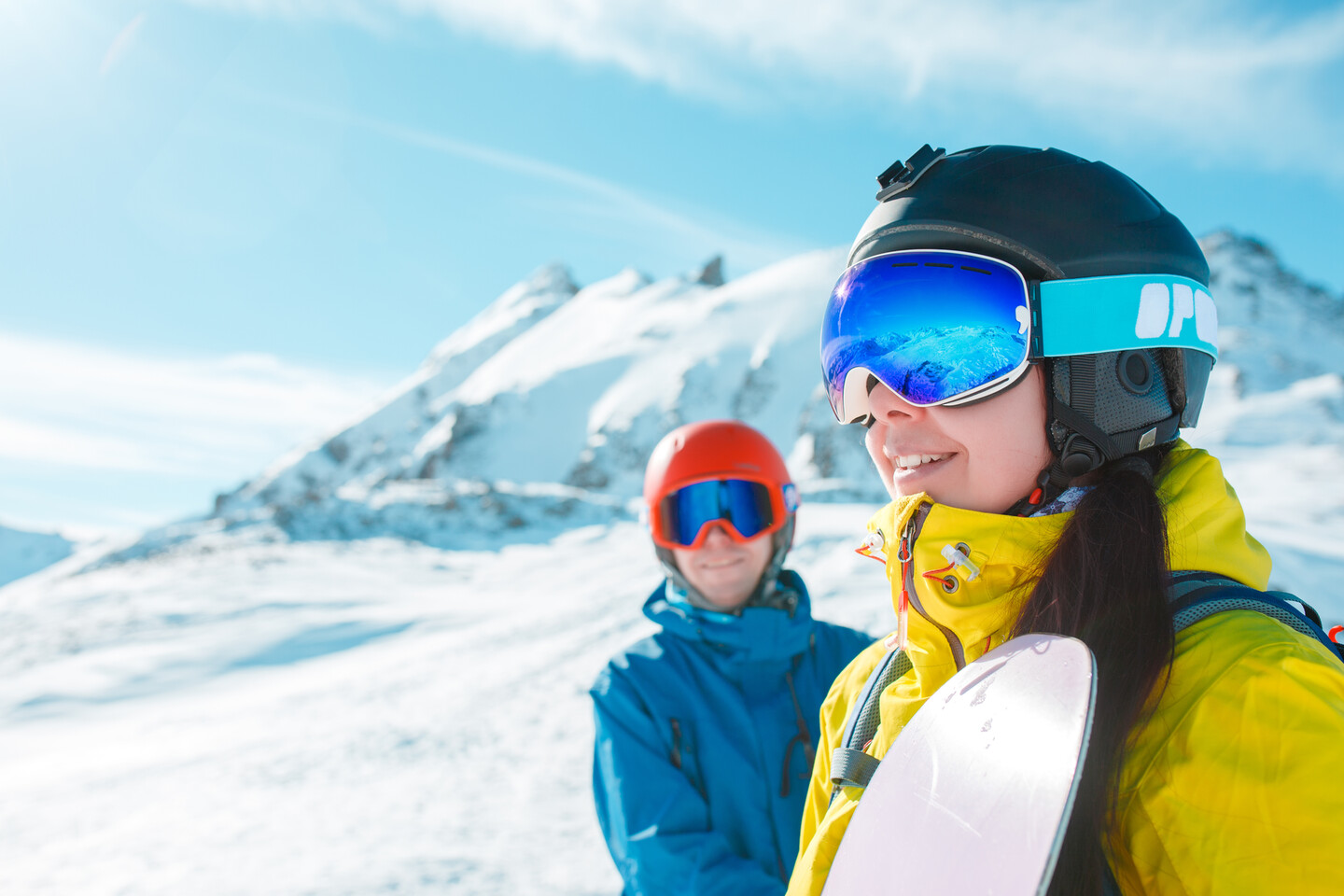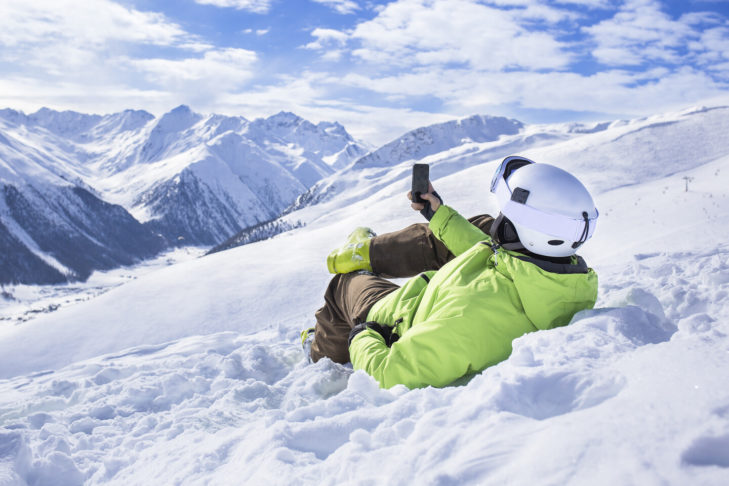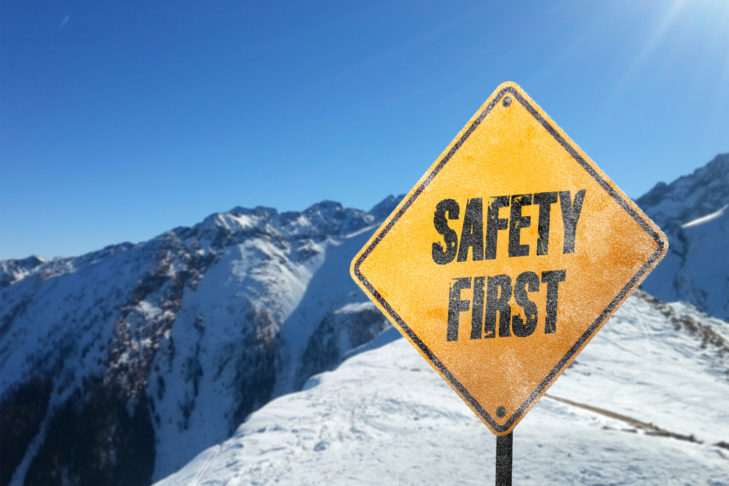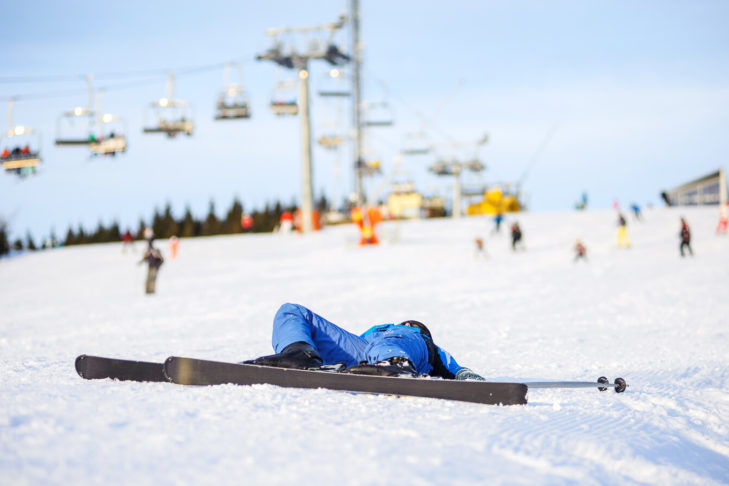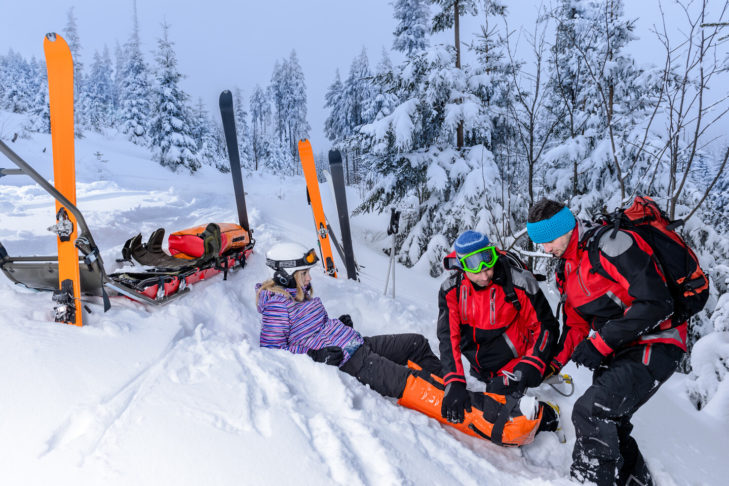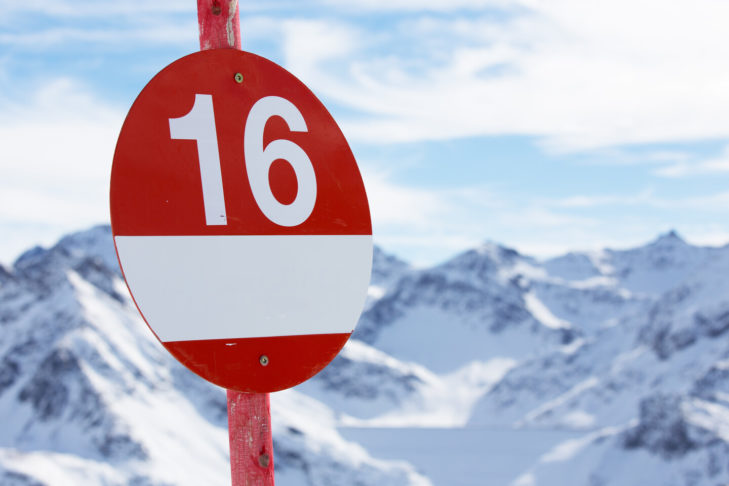Anyone who moves can get injured. This applies to skiing as well as any other sport. However, this should not put anyone off winter sports. With responsible behaviour and adherence to the applicable safety rules, most accidents can be avoided. However, should a ski fall occur on the piste, tried and tested procedures can help to avoid serious injuries and get professional help quickly. SnowTrex shows how winter sports enthusiasts should behave in such situations.
Protection starts before you start skiing
According to various aggregated reports, around 1,000 British skiers required medical treatment after an accident in the 2016/2017 ski season. This is one of the lowest figures ever since winter sports accident statistics began to be recorded. The number of serious injuries in winter sports is also falling accordingly. Nevertheless, there are still too many minor accidents in relative terms. Most of them could be avoided by observing safety rules and descending the slopes with foresight.
Head injuries, bruises to the torso, broken ribs or collarbones and knee injuries are the most common injuries that occur when skiing – and mainly due to falls. The following measures help to prevent falls and the resulting injuries during winter sports: Warm up well before hitting the slopes. Studies show that warming up before sport reduces the risk of injury. Warming up should stretch the muscles and get the circulation going.
It is also important that winter sports enthusiasts drink often and regularly. In other sports, you do this automatically as you get warm and sweat. But when you’re skiing, you don’t notice that you’re sweating or thirsty because of the cold. As a result, you drink less. This means that the risk of dehydration is even higher with winter sports than with other sports. The consequences are headaches, concentration problems and muscle pain. In the worst case, dehydration can lead to circulatory collapse and fainting.
Experts recommend constant drinking before and during sport. The drink should not be too hot or too cold. Low-carbonated mineral water and fruit juice spritzers during breaks are particularly suitable. Soft drinks such as cola or energy drinks are not recommended as they dehydrate the body.
Winter sports enthusiasts should also go to the piste well-rested and in good physical condition. If you don’t feel well, are tired or not completely fit, you will ski carelessly and won’t be able to react quickly enough in dangerous situations. Physical and mental fitness ensure fewer falls on the piste from the outset.
Better safe than sorry
Nevertheless, falls cannot always be prevented. Nevertheless, if you are well prepared on the piste, you can avoid serious injuries. For example, protective clothing can cushion the impact of a ski fall and prevent serious damage. Depending on your level of ability, this includes back armour, but at the very least suitable ski goggles, and of course a helmet. Helmets in particular can reduce the risk and severity of head injuries during winter sports and even save lives.
Another safety measure when skiing is the buddy system, similar to that used in diving. In the event of a fall on the slopes, the ski partner can help. It is advisable to inform a third person who is not travelling with you about the planned routes, especially if you are skiing away from busy slopes. Arrange a time for a meeting or a short phone call with them. If the skiers do not report at the specified time or do not turn up at the meeting point, something could be wrong. The informed person can call for help quickly if necessary, as they know best where the skiers may be. Nevertheless, it is essential to remain calm, as delays can also be caused by poor visibility or heavy traffic.
Of course, winter sports enthusiasts should always have their mobile phone with them, preferably with alpine emergency numbers stored in it. These are the telephone numbers for the Alpine countries with ski resorts:
- Germany: 0049-89-29 49 40 (emergency call: 112)
- Austria: 0043-512-58 78 28 (emergency call: 140)
- Switzerland: 0041-333-333 333 (emergency call: 1414)
- Italy: 0039-0471-99 99 55 (emergency call: 118)
- France: 0033-450-53 22 08 (emergency call: 15)
- Liechtenstein: 41 79 390 06 09 (emergency call: 117)
There are also local emergency numbers for most ski resorts. If you don’t have these numbers on hand, you can call the general emergency number 112 throughout Europe. The emergency services will then notify the appropriate mountain rescue service.
Care should always be taken
A large proportion of falls in winter sports are the result of collisions. More than 15 per cent of accidents are caused by collisions. The German Ski Association describes this as “unacceptable” because the collisions could actually be easily avoided by paying more attention on the slopes. The rules of behaviour of the International Ski Federation FIS are recommended as guidelines for careful, attentive and safe skiing.
Firstly, it is important to behave in such a way that you do not endanger others or yourself. This includes adapting your speed to the piste and weather conditions as well as your own abilities. According to the FIS, many collisions in winter sports are caused by excessive speed or uncontrolled riding behaviour. This can be compared to driving a car: Beginners should not drive too fast because they can easily lose control of their vehicle as a result – and winter sports enthusiasts should behave in exactly the same way.
Before setting off, you should always choose a route that does not endanger other skiers on the piste. The skiers further down the mountain always have priority. Overtaking is permitted. However, you should keep enough distance so as not to frighten other skiers and to avoid collisions.
If you stop on the piste, you should always look around before you start again so that you don’t move into oncoming skiers’ paths. Winter sports enthusiasts are also responsible for any defects in their equipment or for any accidents or falls that result. Therefore, the quality of the equipment should always be checked and the applicable safety standards complied with.
Something important, but sometimes difficult to assess or realise: You shouldn’t overestimate yourself (and your body). If you are tired, take a break. If you realise that your body can’t take any more, you should leave it alone for the day and not push yourself beyond your limits – because the consequences can be serious. Skiers who are overtired are usually less attentive, make mistakes more quickly, overlook other skiers more easily and react more slowly overall. All of this can lead to falls more quickly, putting yourself and others at risk.
It is therefore better to stop earlier or simply take a day off instead of putting your body through too much. This way, you can relax by the fire with a cup of tea and return to the piste the next day feeling rested and fit.
The first rule for falls: Stay calm
So what happens if you do fall? That depends on the type of fall. If you fall without injury, the first thing to do is to get up again as quickly as possible. This way you don’t put yourself or other skiers at risk. To do this, position your skis perpendicular to the piste. Then, with your head uphill, ensure that your skis are right-side-up, 90° away from the downhill direction, and parallel to each other with a small gap between them. This way, you’ll be positioned sideways across the slope, preventing you from sliding further down or starting to move immediately as you stand up.
If you can’t do this quickly enough, you should try to move out of the piste as quickly as possible. In an emergency, simply crawl to the side or into the visible area. If you are unable to do this on your own or have injured yourself, call other skiers for help. It is best to draw attention to yourself by waving and shouting.
Please always check whether you have lost anything in the ski fall or whether something has broken that could injure others or damage equipment. Once you are fit to ski again and your equipment is safe, you can continue your journey. Anyone who witnesses a fall on the slopes, whether it’s their own ski partner or another skier, is obligated to help. The most important thing is not to panic, as this will prevent you from acting calmly and rationally and could make the situation worse.
Anyone who rushes to help and cannot get the fallen person out of the “line of fire” quickly enough should observe the following accident protocol:
- Firstly, remain calm and take stock of the situation.
- The next step is to secure the scene of the accident.
- It is essential to check the fallen person’s injuries.
- Then call for help and administer first aid yourself as best as possible.
Secure the accident site
The first thing to do is to secure the accident site so that no further accidents such as pile-ups occur. To do this, place two ski poles in the shape of an “X” in the snow about five to ten metres above the accident site. Then check the position of the injured person. Clarify whether the person is responsive. If you have not seen exactly what has happened, you should not remove the helmet to protect the spine, unless the injured person cannot breathe through the helmet, has vomited inside it or requires mouth-to-mouth resuscitation. The first step is then to place the person in a safe position, such as the stable lateral position/recovery position. If the person is able to respond, it is best to place them in the position that is most comfortable for them.
Call for help
Only if you are really sure that there is no fracture or concussion and the injured person can move themselves can they be brought to the edge of the piste. Then alert the rescue service and seek help. If you are travelling with several people, you can share the tasks and act more quickly. Other skiers passing by can also be alerted to the situation by shouting and can help to secure the accident site, call the mountain rescue service or provide first aid. They are also important witnesses who can help to draw up an accident report.
If you are in a place without mobile phone reception, it can sometimes help to first switch your mobile phone off and then on again and finally dial 112 instead of the PIN.
Send an alpine distress signal
If you don’t have a mobile phone with you or can’t activate the emergency call, ask other skiers for help. If you are alone or away from the busy pistes without any prospect of approaching help, the alpine emergency signal method comes into play:
This is generally intended for extreme or existential emergencies in which you cannot get help yourself. This involves signalling either visually and/or acoustically that you need help. This can be the waving of a scarf or a light or simply shouting. It is important to repeat this every ten seconds for one minute. Then take a one-minute break and wait to see if anyone responds. If there is no response, you start again from the beginning. Repeat this until someone answers. It is important that you do not stop until you receive a clear answer or are rescued. It is best to continue signalling even after a response so that you can be found.
If you hear or see such an alpine distress signal, call the rescue service immediately and also respond with a signal. This is done by the person answering with 3 signals within one minute, also followed by a pause of one minute.
Answering the critical questions
Anyone who has the opportunity to contact the emergency services should have the answers to the following five critical questions ready:
- Where and when did the accident happen?
- What has happened?
- How many people are injured?
- Who is calling for help?
- What are the weather conditions?
In order to be able to describe the exact location in more detail, skiers should always remember the number of their piste or the name of the lift. If you don’t know this, try to describe the immediate surroundings as well as possible: Are there certain markers or signs? Can you recognise certain buildings? At the end of the call, always wait to see if there are any questions.
Provide first aid and reassure the injured person
If the emergency services are on their way, administer first aid yourself as far as possible. This includes protecting the injured person from hypothermia, but also giving them mental support and reassurance. The German Red Cross has launched a certified first aid app that also works offline and can also be used to initiate first aid measures in an emergency until professional help arrives. As soon as the emergency services arrive, you can show the emergency services the scene of the accident and answer any questions they may have. Such serious accidents are relatively rare in winter sports, but everyone should know what to do in an emergency. This not only helps in the event of an accident, it also makes skiing calmer and safer overall.
Most falls while skiing are caused by carelessness. If you follow the safety rules, ski attentively and carefully and are well protected, you can avoid most accidents and be safe on the slopes. We wish you a good ride!
Please also note that by using our services and integrating the YouTube API Services, the YouTube Terms of Service and the YouTube API Services Terms apply and your use of our website is deemed to be acceptance of these terms.
FAQ’s on proper behaviour in the event of a fall on the slopes
Is skiing dangerous?
As with any sport, accidents can happen during winter sports. However, the number of serious skiing injuries is at an all-time low.
What are the most common skiing injuries?
Injuries to the head, torso and knees are the three most common skiing injuries. They are usually caused by falls.
What is the most common cause of a ski fall?
Collisions lead to most falls in winter sports. These in turn are mainly caused by a skier travelling too fast or too uncontrollably.
Can a ski fall be avoided?
Yes, the majority of falls in winter sports are caused by carelessness. If you ski carefully, are physically fit, adhere to the applicable safety rules and wear appropriate protective clothing, you can avoid falls.
What happens if you witness a ski fall?
Every winter sports enthusiast is obliged to help in the event of an accident. The first step is to secure the accident site, check the status of the injury, call for help and then administer first aid to the injured person.
What should you do if an accident has happened and you have no cellphone (or coverage) and are off the beaten track?
The alpine emergency signal was introduced for such emergencies when there is a chance of being seen from mountain huts or in the valley. A visual or acoustic signal is given every 10 seconds. After one minute (or six signals), you pause for a minute and then start again until a response is received (3 signals per minute with a one-minute pause and repetition) or help arrives.


